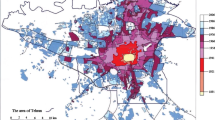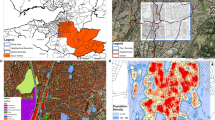Abstract
In addition to enhancing our theoretical grasp of justice, thinking spatially about it can also reveal important new insights that broaden our practical understanding in order to advance justice and democracy. On the other hand, these opportunities won’t be as obvious if the spatial equities aren't made apparent and strong. Austin city has experienced a fast-urban growing in the past decades. As urban areas grow, the public facilities should increase. The purpose of this paper investigates Facilities in terms of public facilities. Even though we said that the concept of justice is very complex, it is possible to get an understanding of it by using a quantitative method. This paper explores the condition of urban justice and opportunities for accessibility to public facilities for all residents in Austin by using GIS data and the Fuzzy logic model. The facilities and services maps were made in GIS and after the Euclidean Distance and Reclassify function in Arc Map, the Fuzzy Logic model was used to analyze spatial justice. The result shows the facilities are distributed properly. Spatial justice is in the context of Austin and residents enjoy spatial justice.





Similar content being viewed by others
Data availability
The data will be available on request to the corresponding author.
Software availability
Software program (ArcGIS software) to draw the map and Euclid distance model and fuzzy logistics are used to analyze the amount of spatial distribution.
References
Marcuse, P., Connolly, J., Novy, J., Olivo, I., Potter, C., & Steil, J. (2009). Searching for the just city: Debates in urban theory and practice. Routledge.
Nikšič, M., & Sezer, C. (2017). Public space and urban justice. Built Environment, 43(2), 165–172.
Dufaux, F., Gervais-Lambony, P., Lehman-Frisch, S., & Moreau, S. (2009). Birth announcement. Justice Spatial/Spatial Justice, 1, 1–2.
Soja, E. W. (2009). The city and spatial justice. Justice Spatiale/Spatial Justice, 1(1), 1–5.
Meyer, N., & Auriacombe, C. (2019). Good urban governance and city resilience: An afrocentric approach to sustainable development. Sustainability, 11(19), 5514. https://doi.org/10.3390/su11195514
Hosseini, A., Farhadi, E., Hussaini, F., Pourahmad, A., & Seraj, N. (2022). Analysis of spatial (in)equality of urban facilities in Tehran: An integration of spatial accessibility. Environment, Development and Sustainability, 24(5), 6527–6555. https://doi.org/10.1007/s10668-021-01715-3
Dikeç, M. (2001). Justice and the spatial imagination. Environment and Planning A, 33(10), 1785–1805. https://doi.org/10.1068/a3467
Soja, E. W. (2013). Seeking spatial justice (Vol. 16). University of Minnesota Press.
Philippopoulos-Mihalopoulos, A. (2014). Spatial justice: Body, lawscape, atmosphere. Routledge.
Harvey, D., Merry, A. H., Royle, L., Campbell, M. P., & Rudd, P. M. (1996). Justice, nature & the geography of difference. Wiley-Blackwell.
Hosseini, A., Pourahmad, A., & Pajoohan, M. (2015). Assessment of institutions in sustainable urban-management effects on sustainable development of Tehran: Learning from a developing country. Journal of Urban Planning and Development, 142(2), 05015009.
Marcuse, P. (2009). Spatial justice: Derivative but causal of social injustice. Spatial Justice, 1(4), 1–6.
Farahani, R. Z., Fallah, S., Ruiz, R., Hosseini, S., & Asgari, N. (2019). OR models in urban service facility location: A critical review of applications and future developments. European Journal of Operational Research, 276(1), 1–27.
Altschuler, A., Somkin, C. P., & Adler, N. E. (2004). Local services and amenities, neighborhood social capital, and health. Social science & medicine, 59(6), 1219–1229.
Steg, L., & Gifford, R. (2005). Sustainable transportation and quality of life. Journal of Transport Geography, 13(1), 59–69.
Rahman, M. H., Ashik, F. R., & Mouli, M. J. (2022). Investigating spatial accessibility to urban facility outcome of transit-oriented development in Dhaka. Transportation Research Interdisciplinary Perspectives, 14, 100607.
Saez, E., & Zucman, G. (2016). Wealth inequality in the United States since 1913: Evidence from capitalized income tax data. The Quarterly Journal of Economics, 131(2), 519–578.
Alvaredo, F. (2018). World inequality report 2018. In World Inequality Report 2018. Harvard University Press.
Hewko, J., Smoyer-Tomic, K. E., & Hodgson, M. J. (2002). Measuring neighbourhood spatial accessibility to urban amenities: Does aggregation error matter? Environment and Planning A, 34(7), 1185–1206. https://doi.org/10.1068/a34171
Mattila, H. (2002). Aesthetic justice and urban planning: Who ought to have the right to design cities? GeoJournal, 58(2–3), 131–138. https://doi.org/10.1023/B:GEJO.0000010832.88129.cc
Martínez, J. (2009). The use of GIS and indicators to monitor intra-urban inequalities. A case study in Rosario, Argentina. Habitat International, 33(4), 387–396. https://doi.org/10.1016/j.habitatint.2008.12.003
Méndez, M. L., & Otero, G. (2018). Neighbourhood conflicts, socio-spatial inequalities, and residential stigmatisation in Santiago, Chile. Cities, 74, 75–82. https://doi.org/10.1016/j.cities.2017.11.005
Shi, Q., & Dorling, D. (2020). Growing socio-spatial inequality in neo-liberal times? Comparing Beijing and London. Applied Geography, 115, 102139. https://doi.org/10.1016/j.apgeog.2019.102139
González, R. C. L. (2019). Urban justice. In A. M. Orum (Ed.), The Wiley Blackwell encyclopedia of urban and regional studies. Wiley-Blackwell. https://doi.org/10.1002/9781118568446.eurs0373
Cho, C. M. (2003). Study on effects of resident-perceived neighborhood boundaries on public services accessibility & its relation to utilization: using Geographic Information System, focusing on the case of public parks in Austin, Texas. Doctoral dissertation, Texas A&M University.
Richardson, H. W. (1979). Aggregate efficiency and interregional equity. In H. Folmer & J. Oosterhaven (Eds.), Spatial inequalities and regional development. Springer. https://doi.org/10.1007/978-94-017-3046-4_7
Dupont, V. (2017). Do geographical agglomeration, growth and equity conflict? Papers Regional Science, 86(2), 193–213. https://doi.org/10.1111/j.1435-5957.2007.00118.x
Grabb, G. (1997). Theories of social inequality—Classical and contemporary perspectives (3rd ed.). Harcourt Canada.
Susan, S., & F. (2014). The just city. International Journal of Urban Sciences, 18(1), 1–18. https://doi.org/10.1080/12265934.2013.834643
Nygren, A. (2018). Inequality and interconnectivity: Urban spaces of justice in Mexico. Geoforum, 89, 145–154. https://doi.org/10.1016/j.geoforum.2017.06.015
Harvey, D. (2010). Social justice and the city (Vol. 1). University of Georgia Press.
Tsou, K. W., Hung, Y. T., & Chang, Y. L. (2005). An accessibility-based integrated measure of relative spatial equity in urban public facilities. Cities, 22(6), 424–435. https://doi.org/10.1016/j.cities.2005.07.004
James, A. (2017). Constructing justice for existing practice: Rawls and the status quo John Rawls (pp. 69–104). Routledge.
Van Pelt, M. (2008). Fuzzy logic applied to daily life. Seattle.
Safdari Molan A., & Farhadi, E. (2019). Spatial analysis of the proximity effects of land use planning on housing prices (case study: Tehran, Iran). In International conference on computational science and its applications (pp. 642–659). https://doi.org/10.1007/978-3-030-24302-9_46
dos Santos, R. S., Şahin Bülbül, M., & Isadora, L. L. (2019). School inequalities and urban welfare: Going beyond socioeconomic status with data science. Acta Scientiae, Canoas, 21(6), 2–27. https://doi.org/10.17648/acta.scientiae.5494
Conti, A., Moura, A. C. M., Martinez, G. A. T., Tondelli, S., & Patata, S. (2021). Applying geodesign in the City of Bologna (Italy): The case study of the Navile Region. In International conference on innovation in urban and regional planning (pp. 265–270). Springer.
Safdari Molan, A., Farhadi, E., Saganeiti, L., & Murgante, B. (2021). Border tourism development strategies in Kaleybar compared to regional rivals. Sustainability, 13(20), 11400. https://doi.org/10.3390/su132011400
Zanganeh Shahraki, S., Hosseini, A., Sauri, D., & Hussaini, F. (2020). Fringe more than context: Perceived quality of life in informal settlements in a developing country: The case of Kabul, Afghanistan. Sustainable Cities and Society journal, 63(12), 102494. https://doi.org/10.1016/j.scs.2020.102494
Greer, J. R. (2002). Equity in the spatial distribution of municipal services: How to operationalize the concepts and institutionalize a program, Doctoral dissertation, University of Texas at Dallas, USA.
Iveson, K. (2011). Social or spatial justice? Marcuse and Soja on the right to the city. City, 15(2), 250–259. https://doi.org/10.1080/13604813.2011.568723
Zanganeh Shahraki, S., Ahmadifard, N., Farhadikhah, H., Fotouhi Mehrabani, B., Haydari, A., Abdali, Y., Abbasi Fallah, V., Farhadi, E., Cividino, S., Vinci, S., & Salvati, L. (2020). Spatial planning, urban governance and the economic context: The case of ‘Mehr’ housing plan Iran. Land, 9(5), 1–13. https://doi.org/10.3390/land9050169
Aqbelaghi, S. A., Ghorbani, M., Farhadi, E., & Shafiee, H. (2018). Environmental approach in modelling of urban growth: Tehran City, Iran. Asian Journal of Water, Environment and Pollution, 15(2), 47–56. https://doi.org/10.3233/AJW-180017
Vignoli, F., de Luca, C., & Tondelli, S. (2021). A spatial ecosystem services assessment to support decision and policy making: The case of the city of Bologna. Sustainability, 13(5), 2787.
Piroozfar, R. (2012). Fuzzy logic: A rule-based approach, in search of a justified decision-making process in urban planning. Doctoral Thesis, Technische Universität Berlin.
Wu, B., Yip, T. L., Xie, L., & Wang, Y. (2018). A fuzzy-MADM based approach for site selection of offshore wind farm in busy waterways in China. Ocean Engineering, 168, 121–132.
Funding
The authors declare that they have no funding source.
Author information
Authors and Affiliations
Contributions
FH made contributions to the gathering of data, its analysis, and its writing. EF helped with data analysis and producing the manuscript. The model’s analysis and application were guided by the AP and ST, who also oversaw the piece.
Corresponding author
Ethics declarations
Conflict of interest
Each author attests that they are not associated with or actively involved in any group or entity that has a financial or non-financial stake in the topics or resources discussed in this article.
Additional information
Publisher's Note
Springer Nature remains neutral with regard to jurisdictional claims in published maps and institutional affiliations.
Rights and permissions
Springer Nature or its licensor holds exclusive rights to this article under a publishing agreement with the author(s) or other rightsholder(s); author self-archiving of the accepted manuscript version of this article is solely governed by the terms of such publishing agreement and applicable law.
About this article
Cite this article
Hussaini, F., Farhadi, E., Pourahmad, A. et al. Spatial justice in relation to the urban amenities distribution in Austin, Texas. Spat. Inf. Res. 31, 113–124 (2023). https://doi.org/10.1007/s41324-022-00484-z
Received:
Revised:
Accepted:
Published:
Issue Date:
DOI: https://doi.org/10.1007/s41324-022-00484-z




